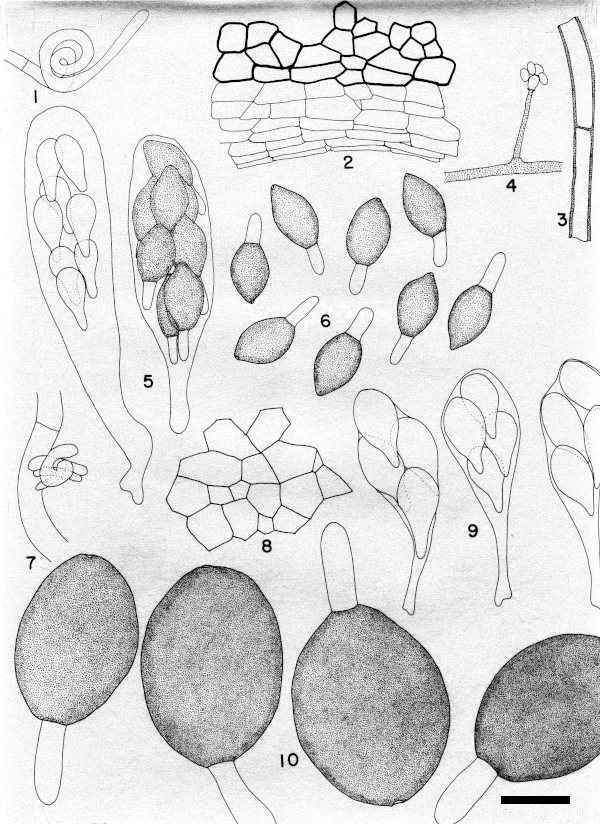Essays >> Cleistothecial Ascomycota >> Cleistothecial Ascomycota - Plate 05
Cleistothecial Ascomycota - Plate 05

1-6. Tripterospora erostrata (Griffiths) Cain
1. Ascomatal initials (X 1900). 2. Ascomatal peridium in cross section (X 1900). 3. Ascomatal hair in cross section (X 1900). 4. Phialide (X 1900). 5. Asci (X 825). 6. Ascospores (X 1900).
7-10. Tripterospora tetraspora J.N. Rai, Mukerji & J.P. Tewari
7. Ascomatal initials (X 1900). 8. Surface of ascomatal peridium (X 825). 9. Asci (X 825). 10. Ascospores (X 1900).
Cai et al. (Mycol. Res. 110: 359-368. 2006), in their detailed analysis of the genus Zopfiella, concluded that Tripterospora, Zopfiella and several other genera included in the Sordariaceae and Lasiosphaeriaceae were highly polyphletc and separated out into several unexpected clades. Thus the two species of Tripterospora grouped on this plate were revealed to be rather distantly related and possibly neither members of that genus. They are maintained here under Tripterospora because they have yet to be convincingly assigned to another genus.
Tripterospora erostrata, commonly treated as Zopfiella erostrata (Griffiths) Udagawa & Furuya, clusters among a group of species labeled by Cai et al. as "Clade C". Among a diversity of taxa representing several genera, this clade also includes Apodus deciduus. Both A. deciduus and T. erostrata grow rather slowly in pure culture, producing dark olive green colonies and ascomata with long flexuous hyphal appendages. The ascomatal appendages are not shown here other than the small fragment shown in Figure 3, but are illustrated explicitly in Cain's original publication (Can. J. Bot. 34: 699-710. 1957.), and are quite similar to those shown in the Apodus drawing.
Tripterospora tetraspora, usually treated as Zopfiella tetraspora(J.N. Rai, Mukerji & J.P. Tewari) S. Ahmad, is quite different from T. erostrata. Although the ascospores, other than size, resemble one another they are quite unlike in their growth in culture. While T. erostrata and A. deciduus produce slow-growing dark blackish green colonies, those of T. tetraspora are pale and rapidly growing, usually covering a petri plate in one week, not developing dark colours until ascomata appear. Cai et al. found that it clustered in the species group characterized as "Clade A", shared by T. longicaudata, the type species of Tripterospora. Clade A mostly contains a mixture of species described in Cercophora and Podospora, but also includes Apiosordaria verruculosa, a species having echinulate ascospores and discussed further in Plate 6.